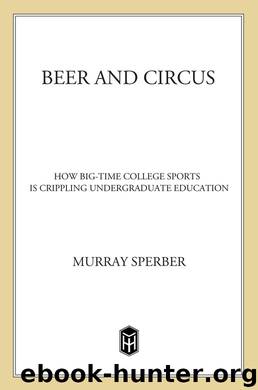Beer and Circus by Murray Sperber

Author:Murray Sperber
Language: eng
Format: epub
Publisher: Henry Holt and Co.
Published: 2011-06-14T16:00:00+00:00
Because massive advertising, direct and indirect, produces excellent sales, the rate of student alcohol consumption increased every year in the 1990s, and it shows no signs of slowing in the twenty-first century. Contributing to the rate, and as effective as the national advertising campaigns, are the promotions by local bars catering to students. As noted during the Tampa drinking tour, college bars often run “cost-leader” specials on weekday nights. Bar managers know that if they can get students inside the door, they will sell them enough alcohol and food to make a profit off of them by closing time. Bars offer “All-You-Can-Drink-Specials” on the cheapest beer available, and limit the time frame, e.g., from 7 P.M. to 9 P.M. Similarly, “Two-for-One” specials often have limited time frames, as do, by definition, “Happy Hours.” But most customers stay in the bar long after the specials have passed; sometimes drinkers remain in place because they can no longer move—all of the specials invite rapid consumption of alcohol.
Another popular inducement is “Ladies Night.” Female customers receive deep discounts all night, with two main results: more males patronize bars on Ladies Night than on any other weekday evening, and females consume far more alcohol that night than during their other trips to the bar. “We’ve never lost a dime on account of a ‘Ladies Night,’” said a bar manager in Iowa City, Iowa, “The guys pack in here paying full price, and we also sell a ton of food at regular prices, plus we get a reputation as a ‘happening place,’ and everybody comes back on the weekend and pays full price then. I love the ladies and Ladies Nights.”
College newspapers are filled with ads for “Ladies Nights” and other special evenings at the local bars. “Lose Those Midweek Blues,” a college town nightclub recommended in a Big Ten student newspaper; “Get over the HUMP NITE,” and coast downhill to the weekend. The inducement was a “$1 cover charge and 10 cent Miller” beer. A bar in a SEC college town advised, “Ease your mind before FINAL EXAMS with our MIND ERASER drink specials.” The Center for Science in the Public Interest noted that for some student newspapers, ad money from local bars constitutes a significant part of their revenue.
This prompts the question: Why do college administrators, now decrying student drinking, permit massive local bar advertising in newspapers that their universities own and subsidize? Banning the ads by official fiat would create free speech problems; however, encouraging student newspapers not to run the ads and agreeing to supplement the lost revenue dollar-for-dollar is a feasible solution. (Universities cover athletic department deficits; it is hoped they could find the money for this more worthy cause.)
Every day, almost every daily paper in America declines to run some sort of ad, thus student newspapers rejecting advertising that so clearly promotes binge drinking will not abrogate their readers’ First Amendment rights. Yet university authorities never explore this option, leading some observers to question whether schools are serious about curtailing binge drinking, or mainly seek to move it off-campus.
Download
This site does not store any files on its server. We only index and link to content provided by other sites. Please contact the content providers to delete copyright contents if any and email us, we'll remove relevant links or contents immediately.
| Administration | Assessment |
| Educational Psychology | Experimental Methods |
| History | Language Experience Approach |
| Philosophy & Social Aspects | Reform & Policy |
| Research |
The Art of Coaching Workbook by Elena Aguilar(50888)
Trainspotting by Irvine Welsh(21496)
Twilight of the Idols With the Antichrist and Ecce Homo by Friedrich Nietzsche(18483)
Fangirl by Rainbow Rowell(9079)
Periodization Training for Sports by Tudor Bompa(8151)
Change Your Questions, Change Your Life by Marilee Adams(7619)
This Is How You Lose Her by Junot Diaz(6765)
Asking the Right Questions: A Guide to Critical Thinking by M. Neil Browne & Stuart M. Keeley(5611)
Grit by Angela Duckworth(5502)
Red Sparrow by Jason Matthews(5375)
Paper Towns by Green John(5075)
Room 212 by Kate Stewart(5020)
Ken Follett - World without end by Ken Follett(4628)
Housekeeping by Marilynne Robinson(4312)
The Sports Rules Book by Human Kinetics(4279)
Double Down (Diary of a Wimpy Kid Book 11) by Jeff Kinney(4192)
Papillon (English) by Henri Charrière(4183)
The Motorcycle Diaries by Ernesto Che Guevara(3997)
Exercise Technique Manual for Resistance Training by National Strength & Conditioning Association(3943)
